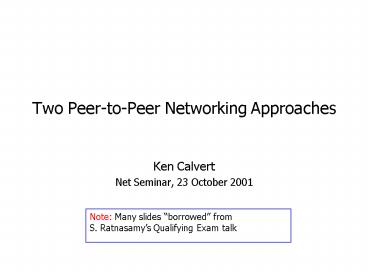Two PeertoPeer Networking Approaches - PowerPoint PPT Presentation
Title:
Two PeertoPeer Networking Approaches
Description:
Napster. Decentralized storage of actual content ... Centralized Index (Napster) Broadcast information to be resolved (Gnutella) Distributed Hashing ... – PowerPoint PPT presentation
Number of Views:59
Avg rating:3.0/5.0
Title: Two PeertoPeer Networking Approaches
1
Two Peer-to-Peer Networking Approaches
- Ken Calvert
- Net Seminar, 23 October 2001
Note Many slides borrowed from S. Ratnasamys
Qualifying Exam talk
2
Peer-to-Peer Networking
- Large-scale symmetric distributed systems
- Overlay networks
- TCP connections as channels
- congestion-controlled (good thing!)
- Random connectivity -- overlay topology is
independent of underlying topology - Very popular!
- ... but money-making potential is unclear
3
P2P Why the Interest?
- Resource sharing on a massive scale
- Files, cycles, equipment, ...
- Decentralized
- Robust, less vulnerable to DOS
- Harder to censor, control
4
P2P File-sharing
- Napster
- Decentralized storage of actual content
- transfer content directly from one peer (client)
to another - Centralized index and search
- Gnutella
- Like Napster, with decentralized indexing
- Search via flooding
- Direct download
5
Napster
128.1.2.3
(xyz.mp3, 128.1.2.3)
Central Napster server
6
Napster
128.1.2.3
xyz.mp3 ?
128.1.2.3
Central Napster server
7
Napster
128.1.2.3
xyz.mp3 ?
Central Napster server
8
Gnutella
9
Gnutella
xyz.mp3 ?
10
Gnutella
11
Gnutella
xyz.mp3
12
The Problem
- Location Resolution
- Given an object (might be name, attribute, or
even content) - Return a channel to a node (peer) that has that
object - Approaches
- Centralized Index (Napster)
- Broadcast information to be resolved (Gnutella)
- Distributed Hashing
13
Distributed Hashing General Approach
Objects
Nodes
- 1. Map both objects and nodes into some topology
(id space)
14
Distributed Hashing General Approach
Objects
Nodes
- 1. Map both objects and nodes into some topology
(id space) - 2. Each node owns some neighborhood in the
topology, has channel to some neighbors
15
Distributed Hashing General Approach
Objects
Nodes
- 1. Map both objects and nodes into some topology
(id space) - 2. Each node owns some neighborhood in the
topology, has channel to some neighbors - 3. Topological structure lets query be routed to
the owner of a given point
16
Design Goals
- Scalability
- Low latency (efficient resolution)
- Load balancing
- Completely distributed/self-organizing
- Robust
- Deployable
- Simple
17
Chord - Basic Idea
- Topology is a ring of ordered, fixed-size IDs
(say 32 bits) - Node ID based on IP address, object ID based on
name, content, ...
0
18
Chord - Basic Idea
- Nodes own the part of the ID space between
their ID and their predecessors ID.
0
19
Chord - Basic Idea
- Each node has a channel to its successors at
distances 1, 2, 4, 8, 16, ..., 2(m-1) - where m log_2 of the ring size (32 in this case)
0
20
Chord Resolution
- Get ID of desired object
- Find the last node whose ID is LESS than the
desired ID - Look in finger table to find farthest-away
neighbor whose ID is LESS than the desired ID - Ask it for somebody closer
- That nodes successor is the owner of the
object
21
Chord Performance
- Resolution O(log N)
- Joining O(log2 N) find all your neighbors
- Doesnt count cost of moving objects that have
a new owner - Stability provable
22
CAN Basic Idea
- virtual coordinate space
- really just a conceptual aid
- entire space is partitioned amongst all the
nodes in the system - every node owns a zone in the overall space
- abstraction
- can store data at points in the space
- can route from one point to another
- point node that owns the enclosing zone
23
CAN Basic Idea
- Topology is an N-dimensional torus
- N2 for simple examples
- Each node is responsible for a subrange in each
dimension - Space is partitioned among all nodes
- Route via neighbors -- move in direction of
destination
24
CAN simple example
1
25
CAN simple example
1
2
26
CAN simple example
3
1
2
27
CAN simple example
3
1
4
2
28
CAN simple example
29
CAN simple example
(K,V)
(a,b)
retrieve (K)
insert (K,V)
hash(K) (a,b)
30
CAN routing table
31
CAN routing
(a,b)
(x,y)
32
CAN node insertion
Bootstrap node
new node
1) Discover some node I already in CAN
33
CAN node insertion
Bootstrap node
I
new node
1) Discover some node I already in CAN
34
CAN node insertion
(p,q)
2) pick random point in space
I
new node
35
CAN node insertion
(p,q)
J
I
new node
3) I routes to (p,q), discovers node J
36
CAN node insertion
new
J
4) split Js zone in half new owns one half
37
CAN node failures
- Simple failures
- know your neighbors neighbors
- when a node fails, one of its neighbors takes
over its zone - More complex failure modes
- simultaneous failure of multiple adjacent nodes
- scoped flooding to discover neighbors
- hopefully, a rare event
- Background zone reassignment algorithm
38
CAN scalability
- For a uniformly partitioned space with n nodes
and d dimensions - per node, number of neighbors is 2d
- average routing path is (dn1/d)/4 hops
- A hop here is an application-level hop
- 1 app-level hop (possibly) multiple IP-level
hops - simulations show that the above bounds hold for
imperfectly partitioned spaces - Can scale the network without increasing per-node
state
39
Summary
- Two similar approaches to locating objects by
computed routing - Similar to Manhattan Street Networks
- Both are scalabe, reasonably robust
- All these P2P networks ignore underlying topology!































